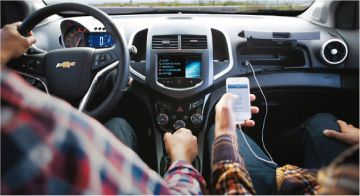
It’s hard to resist the temptation to do two things at once, even when one of those things is driving. To make multitasking easier and safer, automakers and technology companies have provided drivers with the ability to use voice commands to operate smartphones and infotainment systems.
Voice systems do help drivers keep their eyes on the road when compared with manual interfaces, but they don’t eliminate visual distraction altogether, a new study by researchers from IIHS and the Massachusetts Institute of Technology’s AgeLab shows.
When researchers compared embedded voice systems from two vehicle makes and the voice interface of a smartphone, they found considerable differences among the three in terms of the visual demand, time involved and accuracy.
“In an ideal world, drivers wouldn’t do anything but drive while the vehicle is moving. But people are increasingly plugged in at all times, and automakers have responded by installing systems to make it easier to use technology on the go,” says Ian Reagan, an IIHS senior research scientist and a co-author of a pair of papers based on the experimental study. “While you can’t completely eliminate the distracting nature of these types of tasks, this study shows it’s possible to reduce some types of distraction through system design.”
The study was conducted on interstates in the Boston area with 80 participants ages 20-66.
• Half of the group drove a 2013 Chevrolet Equinox equipped with the Chevrolet MyLink system.
• Half drove a 2013 Volvo XC60 with the Volvo Sensus system.
• All participants used a Samsung Galaxy S4 smartphone programmed with the same list of more than 100 contacts and mounted in the center console area.
MyLink and Sensus were chosen for the experiment after an earlier IIHS study revealed big differences between them.
Each driver was trained in the use of the vehicle system while parked and then had to use the system to complete a series of tasks while driving:
• Calling a contact manually,
• Calling a contact using voice commands and
• Entering an address for navigation using voice commands.
• Drivers also were trained in use of the Galaxy S4 and completed the same tasks using the smartphone directly.
The participants were instructed to give priority to safe driving.
None of the voice interfaces eliminated all glances away from the road when calling a contact, but all of them reduced total eyes-off-the-road time to some extent compared with manual calling. The reduction was more substantial for both of the embedded systems, particularly MyLink. The Chevrolet system required an average of 14 seconds of off-road glances for the manual interface and 3 seconds for the voice interface.
Volvo’s voice system required more steps to enter an address than Chevrolet’s but gave drivers the chance to correct errors along the way.
When it comes to cellphones and infotainment systems, many safety advocates are concerned that hands-free and voice-activated systems don’t eliminate cognitive distraction. In the current study, cognitive distraction wasn’t specifically measured
Cognitive distraction can result from all kinds of behaviors, many of which would be impossible to eliminate, such as talking to passengers or daydreaming. Crash avoidance technologies that can prevent or mitigate impending crashes, no matter the cause, represent a promising solution to this problem, and more and more vehicles are being equipped with such systems.
To see the original article go to IIHS (Insurance Institute for Highway Safety)




